New Democracy & ZANU-PF: Zimbabwe’s Revolutionary Path
Africa is once again in the crosshairs of imperialism. After two successful national liberation struggles in Tunisia and Egypt, the US and NATO launched a war of aggression against Muammar Qaddafi the Libyan people. France recently conducted a ruthless bombing campaign in Ivory Coast to oust the nationalist President Laurent Gbagbo. As the 2011 Zimbabwean elections approach, the threat of imperialist intervention in Southern Africa looms dangerously.
Marxist-Leninists uphold President Robert Mugabe and the Zimbabwe African National Union-Patriotic Front (ZANU-PF) as a legitimate anti-imperialist government. However, a closer analysis of present-day Zimbabwe reveals more than a country engaged in a vicious struggle against neo-colonialism; it reveals a revolutionary struggle to construct New Democracy.
New Democracy is a bridge to socialism for the third world.
Among Mao Zedong’s many contributions to Marxism-Leninism was his prescription for building socialism in post-colonial countries. After winning their independence from Japan, the Chinese Communist Party (CCP) sought to build socialism from the ashes of Japan’s colonial system of oppression. However, centuries of severe economic underdevelopment left China somewhere between the backwards Confucian feudalism of the past and the liberal-democratic capitalism of the West and its satellites.
Just as Marx recognized the historical importance and progressive role of capitalism in revolutionizing the relations of production, Mao wrote that “In the course of its history the Chinese revolution must go through two stages, first, the democratic revolution, and second, the socialist revolution, and by their very nature they are two different revolutionary processes.” (1) The liberal-democratic revolutions that brought the bourgeoisie to power centralized industrial production in cities, revolutionized technology through efficiency, and instituted major political reforms, including elections and universal suffrage. However, these progressive changes were accompanied by exploitative wage labor, the creation of a class of property-less workers, the rise of imperialism, and countless other forms of oppression; in a word, capitalism.
The first task facing the Communist Party–the primary contradiction facing the Chinese people–was to destroy “the old colonial, semi-colonial and semi-feudal politics and economy and the old culture in their service,” traditionally the task of the bourgeoisie in building capitalism (1) However, with the Communist Party in control of the state and the relative weakness of the Chinese bourgeoisie, Mao argued that China didn’t have to and shouldn’t create a capitalist economy. The people could achieve all of the progressive democratic and economic changes necessary to lay the material foundation for socialism without enduring the brutal oppression brought on by capitalism. Mao writes that “it is not the old democracy, but belongs to the new category – it is New Democracy.” (1)
Unlike the industrial capitalist economies of the West, China’s class composition was primarily peasant-based, with a strong proletarian presence and some petty-bourgeois shopkeepers in cities. Additionally, colonialism divided the fledgling Chinese bourgeoisie into two camps: those who profited from colonial occupation, and those who strongly preferred national independence. Though the working class must lead the socialist revolution, Mao observed that post-colonial countries without a strong proletariat could undergo a New Democratic revolution. Since the task of the New Democratic revolution, under the leadership of the Communist Party, was to drive out the remaining elements of feudalism, the Party could unite many classes whose positions vis-a-vis colonialism and imperialism were revolutionary. Mao concludes, “Therefore, the proletariat, the peasantry, the intelligentsia and other sections of the petty-bourgeoisie undoubtedly constitute the basic forces determining China’s fate.”
To sum up Mao, New Democracy is “a democratic republic under the joint dictatorship of all anti-imperialist and anti-feudal people led by the proletariat.” It’s a transitional society designed to lay the material foundation for socialist construction.
Zimbabwe’s National Liberation Struggle
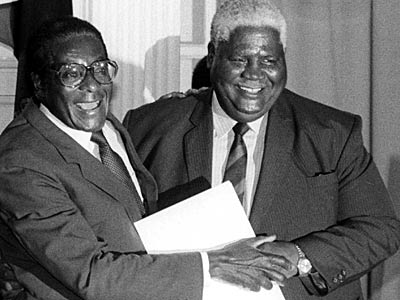
Robert Mugabe of ZANU (left) and Joseph Nkomo of ZAPU (right)
Subject to nearly 80 years of brutal colonial subjugation, Zimbabwe–originally called Rhodesia–functioned as Britain’s primary mining and farming colony in Africa. The racist colonial government of Ian Smith and the Rhodesian Front presided over a rigidly stratified system of apartheid to force indigenous Black Zimbabweans off of their farmland and facilitate British accumulation of the country’s agricultural and mineral wealth. Inequality in Smith’s Rhodesia was so severe that by 1965, White farmers owned 88.5 acres of land for every 1 acre of land owned by a Black farmer, despite White farmers constituting less than 3% of the population. (2)
The dispossessed Zimbabwean masses were ready for revolution, and two parties formed in the early 1960s to lead that struggle against colonialism. Joseph Nkomo, a trade unionist in Bulawayo, formed the Zimbabwe African People’s Union (ZAPU) in 1962 to participate in the general elections that year. After Smith’s racist state banned ZAPU shortly before the elections, several party leaders challenged Nkomo for his willingness to cooperate with the Whites, among them current-President Robert Mugabe. Mugabe and others were expelled from ZAPU and formed the Zimbabwe African National Union (ZANU) in 1963.
While ZAPU had a strong presence in the Zimbabwean trade unions and received support from the Soviet Union, they were never a Marxist-Leninist party. On the other hand, internal party debates in the 1970s led ZANU to officially adopt Marxism-Leninism as their party ideology. ZANU drew substantially from the experiences of the Chinese Communist Party because of the importance they placed on the revolutionary potential of the peasantry.
During the course of the war for liberation–called the Second Chimurenga–ZANU set up an expansive network of people’s councils that gave the Zimbabwean masses the democratic political control they were denied under colonialism. These people’s councils established local clinics, provided health care education, and offered other social services denied to indigenous people by the colonial regime. (3)
Both ZANU and ZAPU extensively practiced the mass line in their organizing, agreeing that successful revolutionaries had to learn from and teach the people by living among them. Their common military orientation towards people’s war led ZANU and ZAPU to form an alliance in the early 1970s. Known as the Patriotic Front, the two parties combined their efforts and repelled the British counter-insurgency, forcing Smith’s government to surrender in 1978.
Zimbabwe’s Unfinished Chimurenga
The Second Chimurenga lasted from its outbreak in 1964 to the Lancaster House Agreement of 1979, in which Britain negotiated the terms for indigenous rule on behalf of the Smith government. Although the Patriotic Front was successful in defeating the Rhodesian Front–who received tremendous financial and military backing from Britain, South Africa, and the United States–nearly 15 years of civil war devastated their ranks and motivated a quick resolution to the conflict.
The Lancaster House Agreement offered a gradual process of restoring indigenous Zimbabweans as the political rulers of their country. This “agreement” was written by the British imperialists to perpetuate their exploitation of Zimbabwe via neo-colonialism. Mahmood Mamdani of the London Review of Books explains the conditions of the Lancaster Agreement:
“Two of its provisions, one economic and the other political, reflected this short-termism: one called for land transfers on a ‘willing buyer, willing seller’ basis, with the British funding the scheme; the other reserved 20 per cent of seats in the House of Assembly for whites – 3 per cent of the population – giving the settler community an effective veto over any amendment to the Lancaster House terms.” (4)
Following the Second Chimurenga, the ZANU-led government nationalized many of the country’s industries, including mining. The Lancaster Agreement was crafted by Western imperialists to prevent massive land reform akin to neighboring Mozambique. Both Britain and the United States pledged to heavily contribute finances for buying back farm land from White settlers in exchange for the Zimbabwean government’s agreement to not expropriate the land.
The Lancaster Agreement was exposed as the imperialist tool it was when Prime Minister Mugabe moved to acquire White farmland for redistribution in the 1980s. White farmers sold back poor-quality land at a value they were allowed to determine through Lancaster’s policy of self-appraisal. By the end of the 1980s, land transfers had declined sharply, and less than “19 per cent of the land acquired between 1980 and 1992 was of prime agricultural value.” (4)
Both Britain and the US reneged on their agreements to contribute financially during land reform, which forced the Zimbabwean government to take substantial loans from the International Monetary Fund (IMF). The IMF provided predatory loans to Zimbabwe on the condition that it privatize many of the essential industries that the masses gained control of during the Second Chimurenga as a part of a Structural Adjustment Plan (SAP).
The SAP launched Zimbabwe into a downward spiral and intensified the social contradictions left unresolved by the Lancaster Agreement. The Zimbabweans who heroically fought for liberation during the Second Chimurenga were justifiably outraged at the continued injustice and began organizing their communities to forcibly take over White farms.
In response to the West’s open rejection of financial assistance for the gradual land reform program of Lancaster, Mugabe and ZANU-PF–a coalition part of ZANU and ZAPU formed in 1989–sanctioned the land seizures and provided state support to expropriation efforts by the Zimbabwean people. These land occupations–called the Fast-Track Land Reform Program (FTLRP)–lasted until 2003 and represented the first major transfer of land from White settlers to indigenous Zimbabweans in the country’s history.
New Democracy & the Fast-Track Land Reform Program

From 2000 - 2003, millions of indigenous Zimbabweans took their land back from White settlers
Zimbabwe became a pariah state in the West for breaking with international capital, and imperialism sought to crush the New Democratic revolution taking place in Southern Africa. Crippling sanctions imposed by the West, along with political unrest fostered by the CIA/MI6-backed Movement for a Democratic Change (MDC), plunged Zimbabwe into turmoil in the latter half of the 2000s. Shamefully but predictably, Western “leftist” groups–themselves almost exclusively white and petty-bourgeois in background–marched in-step to the imperialist war-drum and called for the overthrow of Mugabe and ZANU-PF. Despite this array of enemies, the resilient and tenacious people of Zimbabwe have stood resolute in their revolutionary achievements.
Mugabe has repeatedly said that the Zimbabwean people are engaged in a “Third Chimurenga” aimed at destroying the remnants of colonialism. British colonial rule denied the people of Zimbabwe access to their own economy, leaving the indigenous population impoverished and the means of production underdeveloped. However, Zimbabwe’s open rebellion against imperialism, beginning in 2000 with the FTLRP, has paved the way for the world’s only New Democracy.
In late 2010, Ian Scoones of University of Sussex released the first major academic study of the effects of the FTLRP entitled Zimbabwe’s Land Reform: Myths and Realities. Although the Western media spent ten years denouncing the FTLRP as a failed policy and perpetuating racist myths about Black land ownership, Scoones finds that this revolutionary policy was in no way a failure.
According to Scoones, around 7 million hectacres were taken over and redistributed since 2000. He writes that “Through a combination of agricultural production and off-farm activities, there is a strong dynamic of ‘accumulation from below.’ A new agrarian structure is fast emerging, and centre-stage is an important ‘middle farmer’ group.” (5)
A quick look at the class composition of the beneficiaries of the FTLRP demonstrates its revolutionary character. Scoones’ study finds that 49.9% of those who received land were ordinary Zimbabweans from rural areas; in other words, peasants. 18.3% of land recipients were “unemployed or in low-paid jobs in regional towns, growth points and mines,” and 6.7% were former farm workers; the Zimbabwean proletariat. Civil servants, who largely make up the Zimbabwean petty-bourgeoisie, were 16.5% of the land recipients. The two categories comprising the lowest percentage of land recipients were business persons, at a paltry 4.8%, and security service personnel, at a mere 3.7%. (5)
If ZANU-PF was a bourgeois party, would it have sanctioned and supported a radically egalitarian land reform program like this?
At the same time, the FTLRP stops short of collectivizing agriculture and organizing it along socialist lines. Since the FTLRP is neither capitalist nor socialist, what is it? Let’s look again to Mao for the answer:
“The [New Democratic] republic will take certain necessary steps to confiscate the land of the landlords and distribute it to those peasants having little or no land, carry out Dr. Sun Yat-sen’s slogan of ‘land to the tiller,’ abolish feudal relations in the rural areas, and turn the land over to the private ownership of the peasants. A rich peasant economy will be allowed in the rural areas. Such is the policy of ‘equalization of land-ownership.” (1)
Land was the burning question for Zimbabwe peasants, who were excluded from Zimbabwe’s rich agricultural economy by colonialism. The FTLRP accomplishes the first task of New Democracy, which is “to change the colonial, semi-colonial and semi-feudal form of society into an independent, democratic society.” (1)
Western “leftists” denounce Mugabe and ZANU-PF as a capitalist leader and party, respectively. For ten years, they denounced the FTLRP as a state-sanctioned “Enclosure Act” for the Zimbabwean Black bourgeoisie to acquire land. Ten years later, the facts are in, and these Western “leftists” pay the price for not committing themselves to the people’s struggle. Scoones acknowledges the FTLRP’s revolutionary orientation, writing that “Benefiting from patronage relations and ‘accumulation from above,’ such people are a stark contrast to the majority who are relatively poor people in need of land and keen finally to gain the fruits of independence.” (5)
One of the Western media’s great lies–often repeated by “leftists” today–is that Mugabe sought to bribe war veterans with land in exchange for political support. This falsehood is both offensive and inaccurate. On one hand, the veterans of the Second Chimurenga who sacrificed their lives for Zimbabwe’s liberation should absolutely enjoy the fruits of independence, especially after nearly 20 years of continued exploitation by the imperialist-backed White settlers. However, Scoones’ study found that war veterans “account for only 8.8% of the total.” He notes that most war veterans were peasant and proletarian in class background, writing that “most were, prior to land invasions, farming in the communal areas, a few were living in town…while some were civil servants (often from local government offices).” (5)
In post-colonial countries suffering from underdevelopment, New Democracy lays the material foundation upon which the masses will build socialism. Accordingly in Zimbabwe, the new Black farm owners have invested heavily in the improvement of their land and the development of advanced agricultural techniques. Scoones again finds that “new settlers have cleared land, built homes, purchased farm equipment and invested in livestock. We estimated that on average across sites over US$2,000 had been invested per household in a range of assets and improvements.” (5) ZANU-PF encouraged indigenous investment in the newly acquired land by legally enshrining the FTLRP as irreversible.
Mugabe’s FTLRP has revolutionized the relations of production in rural Zimbabwe by radically democratizing the economy. Scoones explains this transformation particularly well, writing that “Unlike the old dualisms of the past, where large numbers of people were excluded from active participation in the agricultural economy, the processes of accumulation from below mean that new players are involved, benefits are being more widely distributed and economic linkages are more embedded in the local economy.” (5) The land reform provided numerous remarkable opportunities for the people of Zimbabwe to directly participate in this new agrarian economy, signifying the development of actual economic democracy.
The FTLRP succeeded in establishing New Democracy in Zimbabwe, and this exciting development creates the conditions for further revolutionary advances towards socialism. Scoones alludes to this, writing”Land reform has unleashed a process of radical agrarian change. This was not just a modest process of transfer to black beneficiaries as in past attempts at resettlement, and has been the case in other land reform efforts elsewhere in the region. Because of its scale, it fundamentally changed agrarian structure, livelihoods and the rural economy. There are now new people on the land, engaged in new forms of economic activity, connected to new markets and carving out a variety of livelihoods.” (5)
The Third Chimurenga Deals a Blow to Imperialism
With the collapse of the Soviet Union and the extension of imperialist hegemony across the globe, any revolutionary people’s movement deals a blow against this system of oppression. Zimbabwe achieved titular independence in 1979, but it continued to remain firmly under the economic control of the imperialists until the FTLRP in 2000.
The Third Chimurenga was an actual revolution that fundamentally changed the relations of production and put the oppressed classes into power. Just as many ‘democratic’ revolutions of the past occurred in two parts–in America, the revolution of 1776 and the civil war in 1860–Zimbabwe’s New Democratic revolution began with the Second Chimurenga (1964 – 1978) and continued with the Third Chimurenga (2000 – present).
Western imperialism is a wicked leviathan, but it isn’t omnipresent. The Middle East, Central Asia, and Northern Africa have attracted the bulk of its recent attention. However, the remaining socialist countries continue to attract the ire of the United States, evidenced by the war-mongering in the Korean peninsula and the continued trade embargo on Cuba. In all of this, the extreme hostility of Western imperialism towards Zimbabwe, ZANU-PF, and Mugabe seems out of place, especially given the country’s unimpressive fossil fuel deposits.
To fully grasp the threat that revolutionary Zimbabwe poses to imperialism, let’s look to Mao again:
“In this era, any revolution in a colony or semi-colony that is directed against imperialism, i.e., against the international bourgeoisie or international capitalism, no longer comes within the old category of the bourgeois-democratic world revolution, but within the new category. It is no longer part of the old bourgeois, or capitalist, world revolution, but is part of the new world revolution, the proletarian-socialist world revolution. Such revolutionary colonies and semi-colonies can no longer be regarded as allies of the counter-revolutionary front of world capitalism; they have become allies of the revolutionary front of world socialism.” (1)
Zimbabwe isn’t just an anti-imperialist state. It strikes at the heart of imperialism, but its historical role is much more important. The Third Chimurenga places Zimbabwe firmly in the camp of the existing socialist nations, including both the surviving Marxist-Leninist states and the countries experiencing socialist construction in Latin America. Zimbabwe isn’t a socialist country, but as the world’s only New Democracy, it functions as the greatest ally “of the revolutionary front of world socialism.”
Though still engaged in a bitter struggle against Western imperialism and neo-colonialism, the Zimbabwean people–led by Robert Mugabe and ZANU-PF–have boldly taken their destiny into their own hands and embarked down an exciting revolutionary path that ends in socialism.
Is ZANU-PF a revolutionary socialist party?
ZANU’s commitment to Marxism-Leninism during the Second Chimurenga is unquestionable, evidenced both in their party documents and actions. In 1989, when ZANU and ZAPU officially merged to form ZANU-PF, the new party’s first constitution established six “Aims and Objects” in Article 2. Prominent among them were these two:
- “To establish and sustain a socialist society guided by Marxist-Leninist principles but firmly based on our historical, cultural and social experience and to create conditions for economic independence, increased productivity and equitable distribution of the wealth of the nation;
- To continue to participate in the worldwide struggle for the complete eradication of imperialism, colonialism and all forms of racism. Accordingly, the party shall support liberation movements in their just struggle for self-determination and social justice.” (6)
However, ZANU-PF is a mass party, and not a vanguard party as Lenin outlined in What Is To Be Done? Membership is open to any Zimbabwean citizen regardless of ideological commitment and class background. This reflects the material political reality of Zimbabwe left by the Lancaster Agreement, rather than some ideological departure from Lenin. Britain demanded a multi-party parliamentary system to protect its economic interests from the revolutionary ambitions of a one-party Marxist-Leninist state.
Although White settlers are no longer guaranteed 10% of the Parliament, ZANU-PF has not consolidated the Zimbabwean democratic system into a one-party New Democracy and must thus compete against other parties during periodic elections. Incidentally, ZANU-PF and its predecessor, ZANU, has won every election since independence.
Nevertheless, ZANU-PF maintains the internal structures of a Marxist-Leninist vanguard party. The People’s Congress–comprised of representatives from ZANU-PF mass organizations, like the National Council of the Women’s League–elects the 160 members of the Central Committee. Eighteen representatives from standing mass organizations and four elected at-large members comprise the Politburo, which is the party’s highest authority. (6)
Leading up to the 2005 parliamentary elections, ZANU-PF published the “ZANU-PF Election Manifesto,” which describes the party as “a vanguard Party of Principles, always leading in mobilizing the broad masses towards the resolution of the National Question,” in this case referring to Zimbabwe’s ongoing struggle for national liberation. (7) The mode of continuing their national liberation struggle, according to the manifesto, is through reinforcing and expanding the FTLRP.
The manifesto extensively dissects ZANU-PF’s resistance to neo-colonialism and imperialism. One passage in particular reads, “Under ZANU-PF, Zimbabwe continues to pursue a robust and independent foreign policy, which embodies the aspirations of the developing world. The policy eschews imperialism or any other form of domination of one people by another.” (7) Later in the document, the party explicitly denounces the US invasion of Iraq in 2003 and expresses solidarity with oppressed nations in the Middle East, reflecting ZANU-PF’s internationalist orientation.
Consistent with their ideological roots in Mao Zedong-thought, ZANU-PF maintains close economic and political relations with China. In late December 2010, Mugabe announced that ZANU-PF was establishing ideological schools for party youths to learn about Zimbabwe’s war for liberation and the role of the party in Zimbabwean society. The Central Committee report detailing these cadre schools stated that they would use the Chinese Communist Party’s schools as a model. (8)
The most salient criteria in evaluating the revolutionary credentials of ZANU-PF are its internal class composition and the class interest it represents. The party’s mass base is an amalgamation of peasants, farmers, security personnel, and war veterans, the latter of whom cut across class lines.
The hostile economic conditions created by Western imperialism via sanctions have at times turned people against governments that represent their class interests. For instance, although the MDC attracted greater support from urban trade unions in the 2008 elections than ZANU-PF did, this stemmed from the high inflation, which itself was brought on by the IMF’s restriction of credit to Zimbabwe.
When confronted with a crippling civil service worker strike in February 2010, the coalition government agreed that the demanded 300% wage increases were unrealistic given the state of the economy. The MDC blamed ZANU-PF for Zimbabawe’s poor economic conditions because of the latter’s refusal to capitulate to the US and Britain’s demands for political reforms. However, Wikileaks released a damning cable from the US embassy in Harare in December 2009, which shows that MDC leader Morgan Tsvangirai urged the US and Britain to continue their devastating economic sanctions. (9) By standing resolutely against the West’s sanctions, which harm the wages of civil service workers through economic deterioration and reduced revenues, ZANU-PF represents the interests of the Zimbabwean proletariat whether they support the party in elections or not.
While certainly not a Marxist-Leninist vanguard party, ZANU-PF remains the leading force in Zimbabwe’s New Democratic revolution. The party maintains an official line condemning Western imperialism, specifically mentioning Iraq, and continues to promote New Democracy through the FTLRP. Its class orientation still predominantly peasant, although all of the anti-imperialist anti-colonial classes are represented.
The Zimbabwean masses are anxious for socialism. With ZANU-PF leading the nation’s New Democratic revolution, Zimbabwe will continue its striking blows against imperialism for the liberation of oppressed people everywhere.
Long Live Independent Zimbabawe!
Onward, ZANU-PF!
Victory to the Third Chimurenga!
(1) Mao Zedong, On New Democracy, 1940, Published 1967 by Foreign Languages Press, Peking
(2) D.G. Clark, “Land Inequality and Income Distribution in Rhodesia”, African Studies Review, Vol. 18, No. 1, April 1975, pg. 4
(3) Colin Stoneman; Lionel Cliffe, Zimbabwe: Politics, Economics and Society, Pinter Publishers, 1989, pg. 25 – 28
(4) Mahmood Mamdani, “Lessons of Zimbabwe”, London Review of Books, Vol. 30, No. 23, December 4, 2008, pg. 17 – 21, http://www.lrb.co.uk/v30/n23/mahmood-mamdani/lessons-of-zimbabwe
(5) Ian Scoones, Nelson Marongwe, Blasio Mavedzenge, Jacob Mahenehene, Felix Murimbarimba, and Chrispen Sukume. Zimbabwe’s Land Reform: Myths & Realities. Harare: Weaver, 2010. Print.
(6) Party Constitution. Harare: Zimbabwe African National Union (Patriotic Front), 1989. Print.
(7) “ZANU-PF Election Manifesto – March 2005”, http://www.kubatana.net/docs/polpar/zanupf_parl_manifesto_2005.pdf
(8) Zimbabwe News Online, “Zanu (PF) to Set up party doctrine schools,” December 23, 2010, http://zimbabwenewsonline.com/politics/1942.html
(9) David Smith, The Guardian, December 27, 2010, “Morgan Tsvangirai faces possible Zimbabwe treason charge,” http://www.guardian.co.uk/world/2010/dec/27/wikileaks-morgan-tsvangirai-zimbabwe-sanctions
Posted on April 22, 2011, in Zimbabwe and tagged africa, china, colonialism, imperialism, mao, marxism-leninism, mugabe, national liberation, neo-colonialism, new democracy, zimbabwe. Bookmark the permalink. 2 Comments.
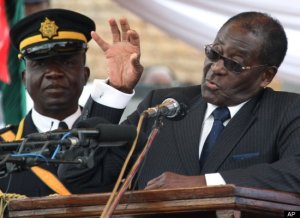
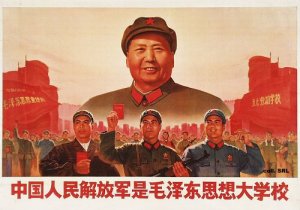

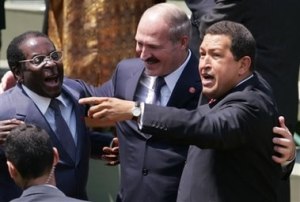
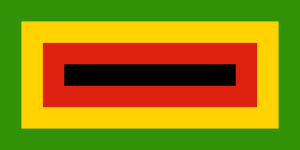
The ‘Revolutionary’ path of Zimbabwe as you call it has led to a massive economic failure that has not been Proletarian based and has simply been based on some mutated form of State-Capitalism. It has allowed for the vast exploitation of members of the Urban Proletariat whom are still forced into the township life that had been forced upon them through the abuses of Smith. As opposed to crushing the conditions and bringing about a Proletarian ruled society in which the Working Class can flourish and control their own destiny, the ruling class of Zimbabwe is simply negligent to this and opposed to the Working Class taking their own destiny in their own hands and using it to their advantage. Instead however, what occurs in Zimbabwe is a vast amount of concessions from a Bourgeois elite who act criminal with each action and this shouldn’t be ignored. While Imperialism does indeed threaten Zimbabwe, it is not the solution of the Anti-Imperialist to identify with a regime that massively exploits the Working-Class it is the duty of the Anti-Imperialist to oppose Imperialist reactions and threatening of regimes around the world due to the needs of Imperialist regimes to accumulate capital and spread their own foreign policy.
I would’ve hoped you would have grasped Captain Sankara’s words and the concepts that he had pushed forward. The very people that Captain Sankara had went against are currently holding power in Zimbabwe, they are those who massively exploit the population, support Popular Front politics that aren’t in the working class interests and keep leeching from society through their own personal needs, as Mugabe has done. In fact– Captain Sankara launched his own coup in response to the betrayal of the previous democratic realization of Burkina Faso, only to in the end be betrayed by the same Mugabe prototype that has offered concessions as opposed to changing the actual conditions, that has abused authority simply in order to support their own ambitions.
May I recommend Sankara’s We Are Heir’s of the World’s Revolutions and literally any other work by Thomas Sankara in order to realize the faults in your thinking.
As well, I would like to say that the ‘collective’ farms in Zimbabwe are nothing of the sort. The ‘Collectivization’ has amounted to nothing and has simply changed the owners of the farms. The owners of the farm have the same positions as the previous owners, except they’re a different color. The peasant class has no form of council control over these farms, and they’re still in the same impoverished socially backward situation that they were before. A revolutionary demand would be to change this and to allow the peasant class to form Councils to control their own labor and to allow them all to have the ability to democratize the place in which they labor, as the fruits of their labor are to be shared by the entire community and they’re dependent on those that work in the agricultural field. If this were to occur, it would truly be revolutionary, it would be a victory for the working class combined with nationalization, this would be a true Worker’s State in the making.
As well, the Zimbabwean Government massively falls through in the areas that the Zimbabwean Army isn’t built out of the people. It is built out of a New Class mentality, a soldier class that has its fundamental founding in feudal barbarism. As opposed to the Zimbabwean Army acting in the interests of the people, producing alongside the people, teaching the people and being one with the people. It is simply another class that doesn’t act as the people do, it acts in its own interests and for its own interests. This yet again, is simply another showing of the betrayal of the Zimbabwean people.
While the Smith Government may be gone and the victory of overcoming Apartheid has been achieved, we must not delude ourselves into supporting these New Class prototypes that have exploited the working class. Nor should we support politics that are National Bourgeois… As the National Bourgeois in no form are Revolutionary Socialists nor do they represent the Proletariat.
Comrade, I would hope you re-examine your thinking regarding certain issues and no longer extend your support to the National Bourgeois that repress the Working Class. Anti-Imperialism must be indeed adopted and upheld, but extending support to the National Bourgeois is not a form of Anti-Imperialism, it is simply accepting the Bourgeoisie rule even further and allowing it to exist simply because it seems different and altering from the other section of the ruling class.
-RedFlags
Pingback: Constitutional referendum, presidential elections to be held in Zimbabwe « The prison gates are open…